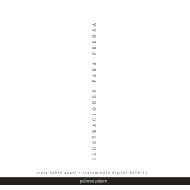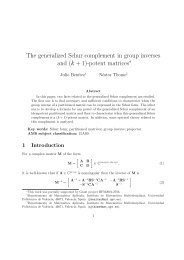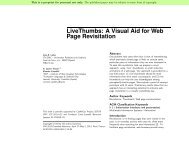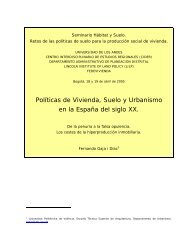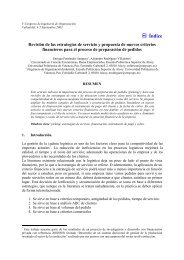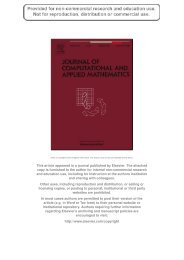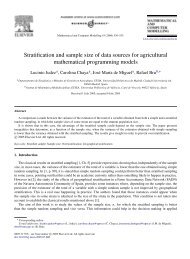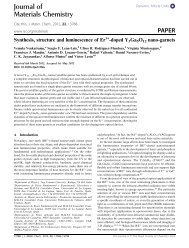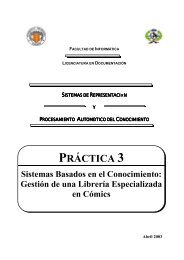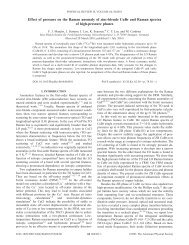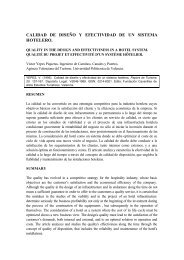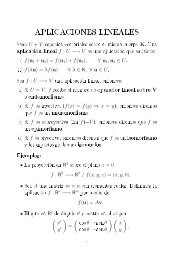Introduction to the resistivity surveying method. The resistivity of ...
Introduction to the resistivity surveying method. The resistivity of ...
Introduction to the resistivity surveying method. The resistivity of ...
Create successful ePaper yourself
Turn your PDF publications into a flip-book with our unique Google optimized e-Paper software.
19<br />
2.5.7 Summary<br />
If your survey is in a noisy area and you need good vertical resolution and you have<br />
limited survey time, use <strong>the</strong> Wenner array. If good horizontal resolution and data coverage is<br />
important, and your <strong>resistivity</strong> meter is sufficiently sensitive and <strong>the</strong>re is good ground contact,<br />
use <strong>the</strong> dipole-dipole array. If you are not sure, or you need both reasonably good horizontal<br />
and vertical resolution, use <strong>the</strong> Wenner-Schlumberger array with overlapping data levels. If<br />
you have a system with a limited number <strong>of</strong> electrodes, <strong>the</strong> pole-dipole array with<br />
measurements in both <strong>the</strong> forward and reverse directions might be a viable choice. For<br />
surveys with small electrode spacings and good horizontal coverage is required, <strong>the</strong> pole-pole<br />
array might be a suitable choice.<br />
2.6 Computer interpretation<br />
After <strong>the</strong> field survey, <strong>the</strong> resistance measurements are reduced <strong>to</strong> apparent <strong>resistivity</strong><br />
values. Practically all commercial multi-electrode systems come with <strong>the</strong> computer s<strong>of</strong>tware<br />
<strong>to</strong> carry out this conversion. In this section, we will look at <strong>the</strong> steps involved in converting<br />
<strong>the</strong> apparent <strong>resistivity</strong> values in<strong>to</strong> a <strong>resistivity</strong> model section that can be used for geological<br />
interpretation.<br />
2.6.1 Data input and format<br />
To interpret <strong>the</strong> data from a 2-D imaging survey, a 2-D model for <strong>the</strong> subsurface<br />
which consists <strong>of</strong> a large number <strong>of</strong> rectangular blocks is usually used (Figure 15a). A<br />
computer program is <strong>the</strong>n used <strong>to</strong> determine <strong>the</strong> <strong>resistivity</strong> <strong>of</strong> <strong>the</strong> blocks so that <strong>the</strong> calculated<br />
apparent <strong>resistivity</strong> values agree with <strong>the</strong> measured values from <strong>the</strong> field survey. <strong>The</strong><br />
computer program RES2DINV.EXE will au<strong>to</strong>matically subdivide <strong>the</strong> subsurface in<strong>to</strong> a<br />
number <strong>of</strong> blocks, and it <strong>the</strong>n uses a least-squares inversion scheme <strong>to</strong> determine <strong>the</strong><br />
appropriate <strong>resistivity</strong> value for each block. <strong>The</strong> location <strong>of</strong> <strong>the</strong> electrodes and apparent<br />
<strong>resistivity</strong> values must be entered in<strong>to</strong> a text file which can be read by <strong>the</strong> RES2DINV<br />
program. <strong>The</strong> program manual gives a detailed description <strong>of</strong> <strong>the</strong> data format used. As an<br />
example, part <strong>of</strong> an example data file LANDFILL.DAT, is shown below with some<br />
comments :-<br />
Data in file<br />
Comments<br />
LANDFILL SURVEY ; Name <strong>of</strong> survey line<br />
3.0 ; Smallest electrode spacing<br />
1 ; Array type (Wenner = 1, Dipole-dipole = 3, Schlumberger = 7)<br />
334 ; Total number <strong>of</strong> measurements<br />
1 ; Type <strong>of</strong> x-location for datum points (1 for mid-point).<br />
0 ; Flag for I.P. data (enter 0 for <strong>resistivity</strong> data only)<br />
4.50 3.0 84.9 ; <strong>The</strong> x-location, electrode spacing, apparent <strong>resistivity</strong> value<br />
7.50 3.0 62.8 ; <strong>The</strong> same information for o<strong>the</strong>r data points<br />
0.50 3.0 49.2<br />
13.50 3.0 41.3<br />
16.50 3.0 34.9<br />
19.50 3.0 31.6<br />
22.50 3.0 25.2<br />
25.50 3.0 27.0<br />
28.50 3.0 22.4<br />
Copyright (1999-2001) M.H.Loke



